coolant level CHEVROLET SUBURBAN 1994 Owners Manual
[x] Cancel search | Manufacturer: CHEVROLET, Model Year: 1994, Model line: SUBURBAN, Model: CHEVROLET SUBURBAN 1994Pages: 385, PDF Size: 19.88 MB
Page 141 of 385
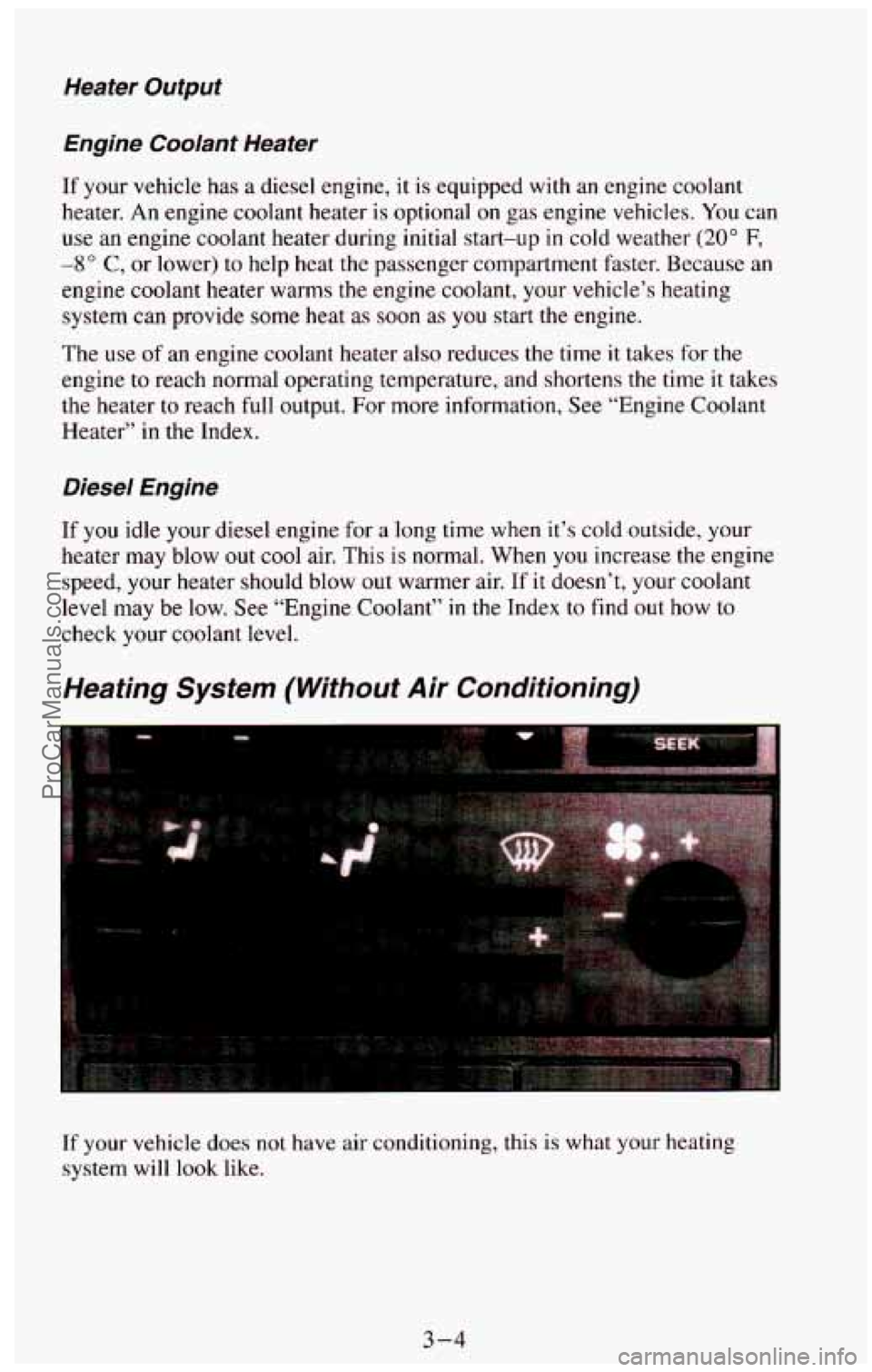
Heater Output
Engine Coolant Heater
If your vehicle has a diesel engine, it is equipped with an engine coolant
heater. An engine coolant heater
is optional on gas engine vehicles. You can
use an engine coolant heater during initial start-up
in cold weather (20” F,
-8” C, or lower) to help heat the passenger compartment faster. Because an
engine coolant heater warms the engine coolant, your vehicle’s heating
system can provide some heat as soon as you start the engine.
The use
of an engine coolant heater also reduces the time it takes for the
engine to reach normal operating temperature, and shortens the time it takes
the heater
to reach full output. For more information, See “Engine Coolant
Heater” in the Index.
Diesel Engine
If you idle your diesel engine for a long time when it’s cold outside, your
heater may blow out cool air. This is normal. When you increase the engine
speed, your heater should blow
out warmer air. If it doesn’t, your coolant
level may be low. See “Engine Coolant”
in the Index to find out how to
check your coolant level.
Heating System (Without Air Conditioning)
If your vehicle does not have air conditioning, this is what your heating
system will look like.
3-4
ProCarManuals.com
Page 216 of 385
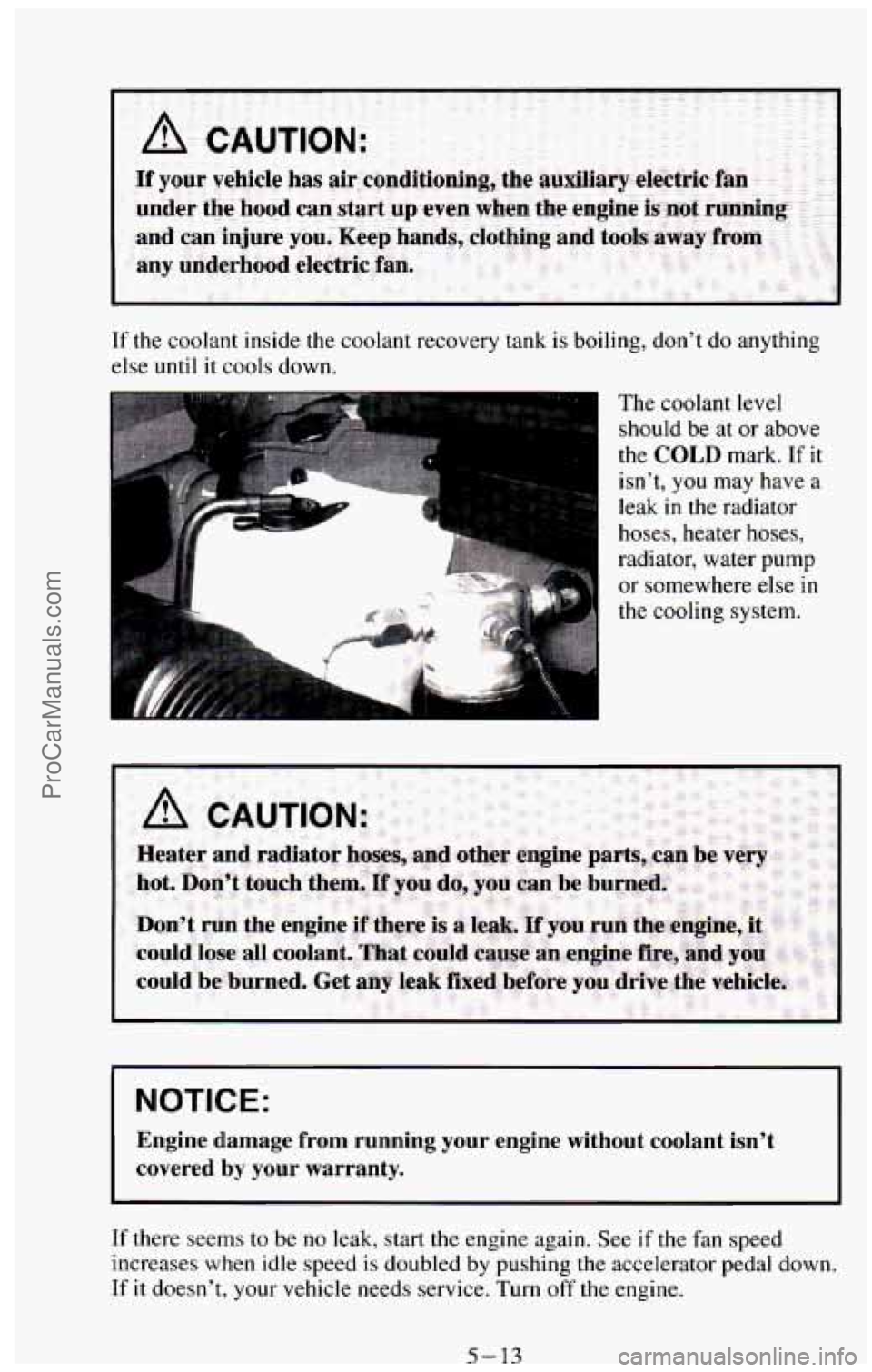
If the coolant inside the coolant recovery tank is boiling, don’t do anything
else until it cools down.
P
The coolant level
should be at or above
the
COLD mark. If it
isn’t,
you may have a
leak in the radiator
hoses, heater hoses,
radiator, water
pump
or somewhere else in
the cooling system.
NOTICE:
Engine damage from running your engine without coolant isn’t \
covered
by your warranty.
If there seems to be no leak, start the engine again. See if the fan speed
increases
when idle speed is doubled by pushing the accelerator pedal down.
If it doesn’t, your vehicle needs service. Turn off the engine.
5-13 ProCarManuals.com
Page 217 of 385
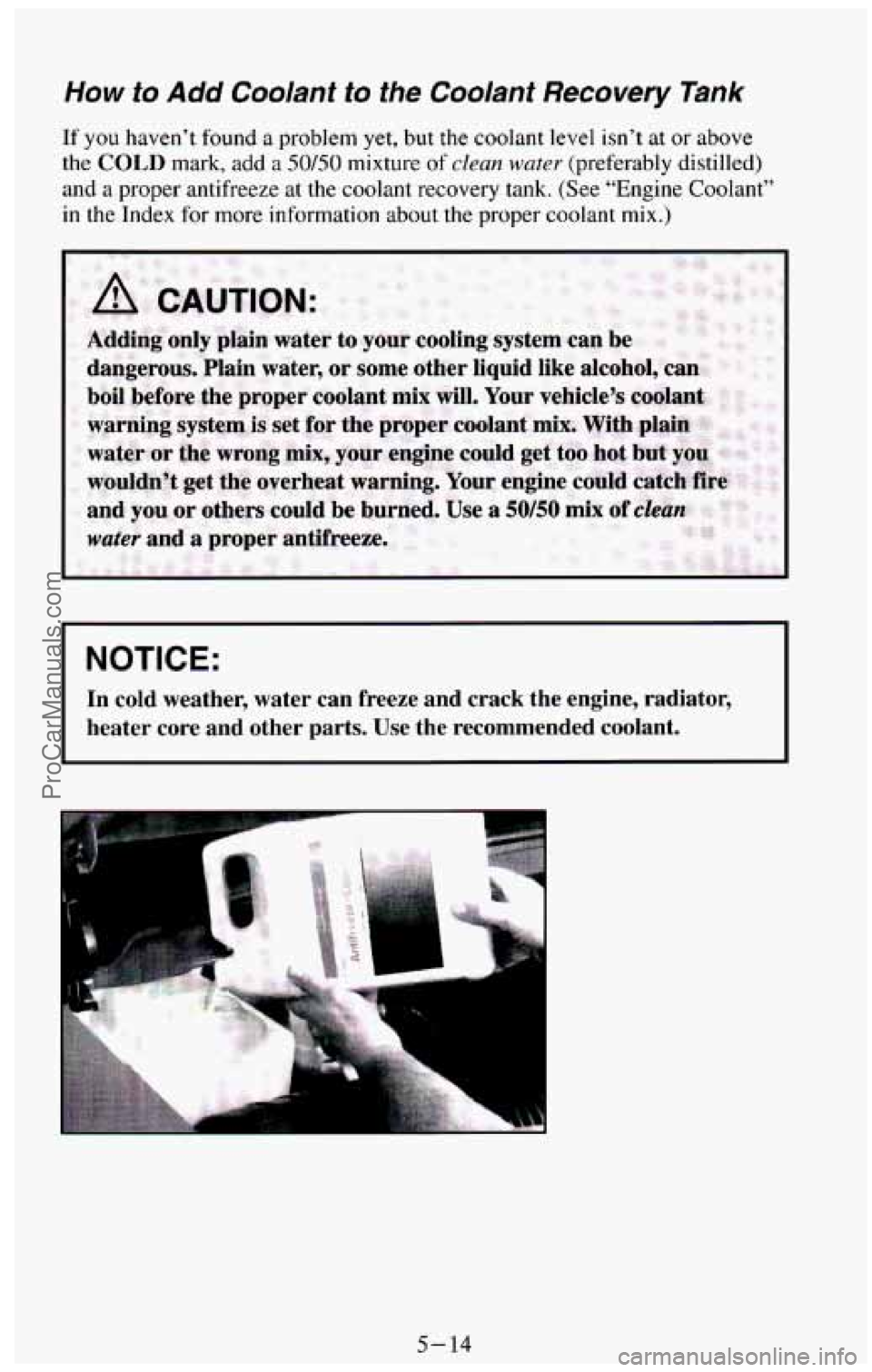
How to Add Coolant to the Coolant Recovery Tank
If you haven’t found a problem yet, but the coolant level isn’t at or above
the
COLD mark, add a 50/50 mixture of clean water (preferably distilled)
and a proper antifreeze at the coolant recovery tank. (See “Engine Coolant”
in the Index for more information about the proper coolant mix.)
NOTICE:
In cold weather, water can freeze and crack the engine, radiator, \
heater core and other parts.
Use the recommended coolant.
5-14
ProCarManuals.com
Page 221 of 385

6. Start the engine
and let it run until
you can feel the
upper radiator
hose getting hot.
Watch
out for the
engine fan(s).
By this time the coolant level inside the radiator filler neck may be
lower.
If the level is lower, add more of the proper mix through the
filler neck
until the level reaches the base of the filler neck.
8. Then replace the
pressure cap. At
any time during
this procedure
if
coolant begins to
flow out of the
filler neck,
reinstall the
pressure cap. Be
sure the arrows
on pressure cap
line up
like this.
Cooling System -Diesel Engines
When you decide it's
safe
to lift the hood,
here's what
you'll see:
A
A. Coolant surge
tank pressure cap
B. Engine fan(s)
C. Radiator
5-18
ProCarManuals.com
Page 222 of 385
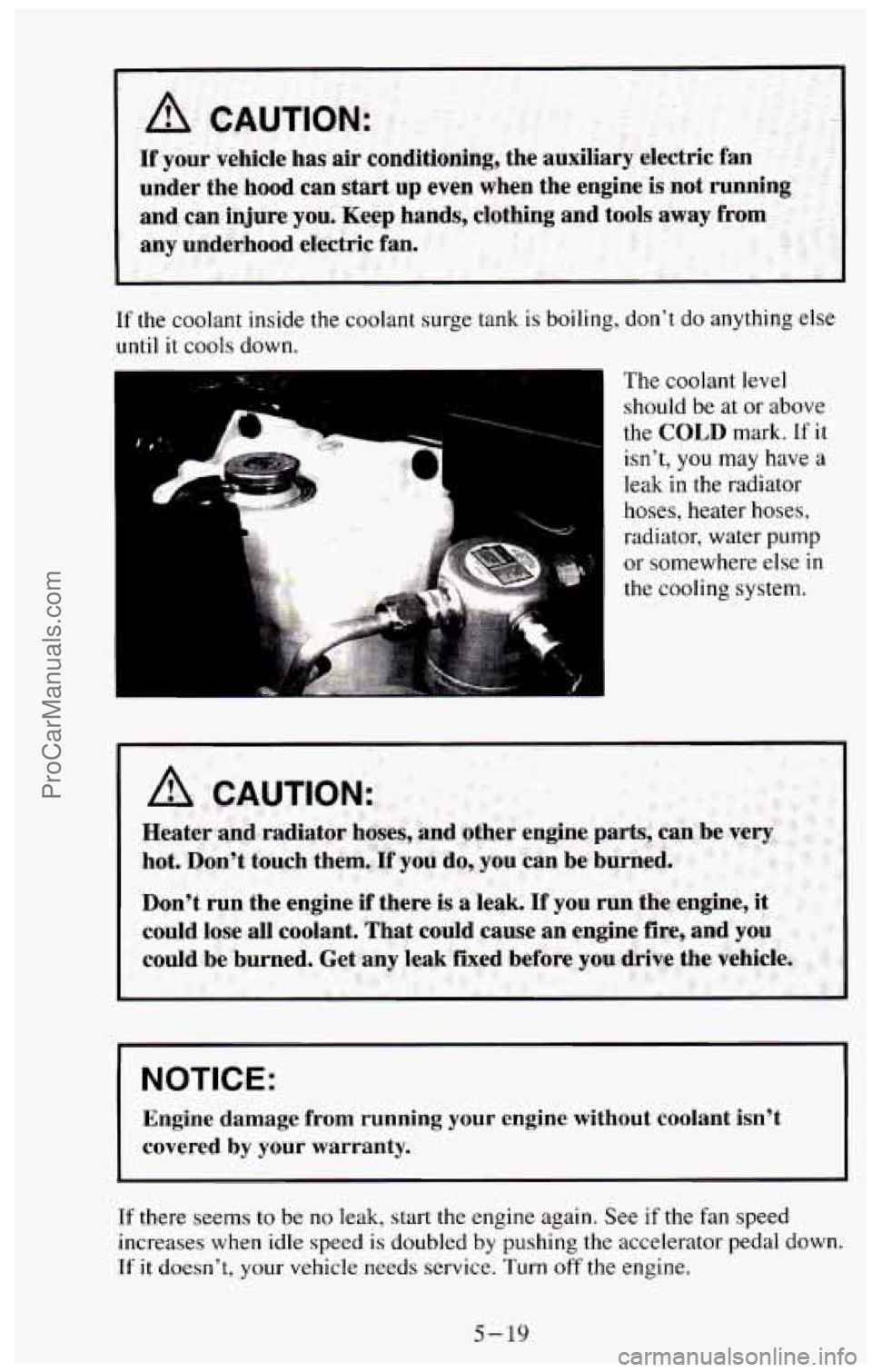
If the coolant inside the coolant surge tank is boiling, don't do anything else
until it cools down.
The coolant level
should be at
or above
the
COLD mark. If it
isn't, you may have
a
leak in the radiator
hoses, heater hoses,
radiator, water
pump
or somewhere else in
the cooling system.
NOTICE:
Engine damage from running your engine without coolant isn't
covered by your warranty.
If there seems to be no leak, start the engifie again. See if the fan speed
increases when idle speed
is doubled by pushing the accelerator pedal down
If
it doesn't, your vehicle needs service. Turn off the engine.
5-19
ProCarManuals.com
Page 223 of 385
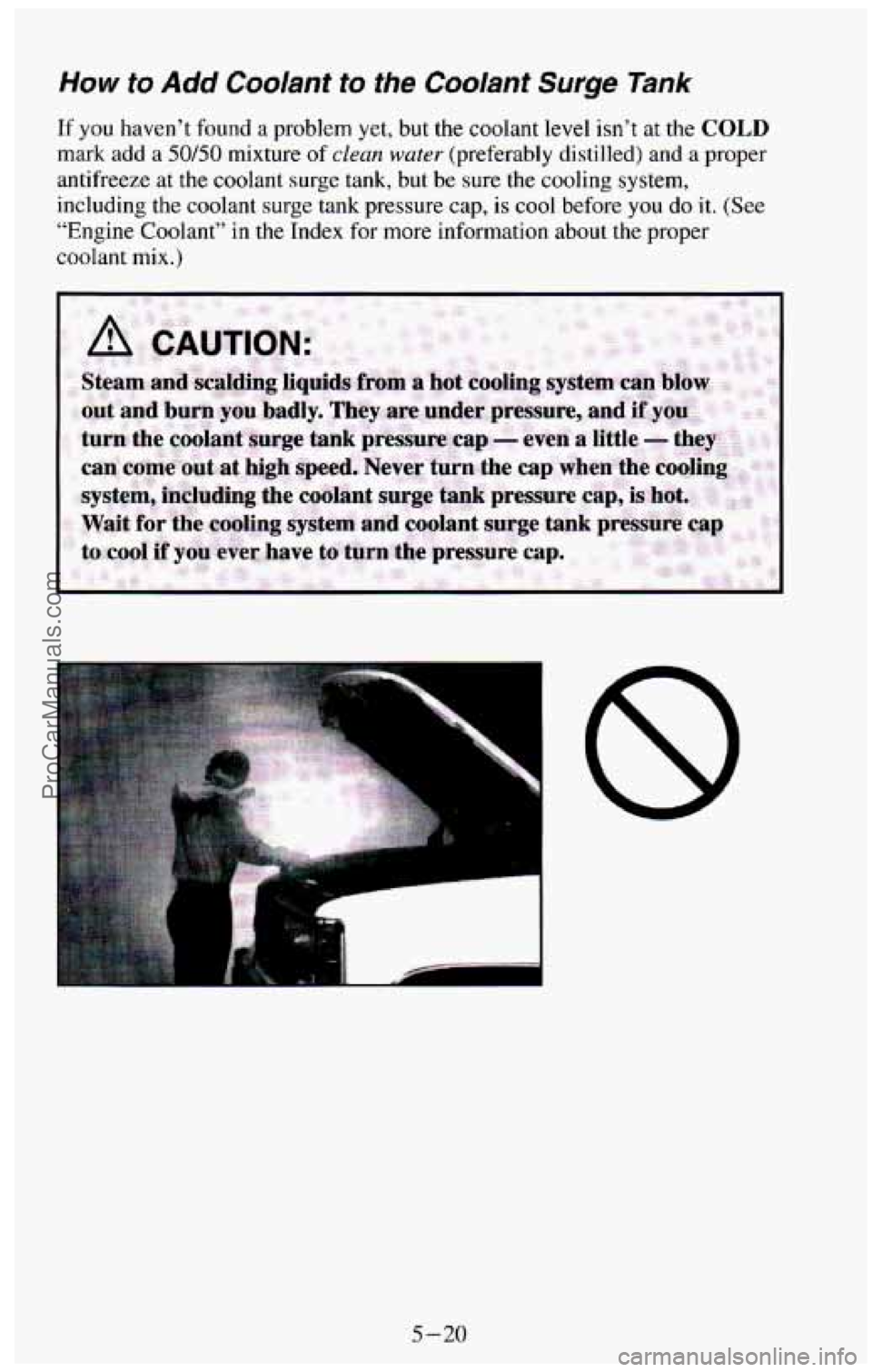
How to Add Coolant to the Coolant Surge Tank
If you haven’t found a problem yet, but the coolant level isn’t at the COLD
mark add a 50/50 mixture of clean water (preferably distilled) and a proper
antifreeze
at the coolant surge tank, but be sure the cooling system,
including the coolant surge tank pressure cap,
is cool before you do it. (See
“Engine Coolant”
in the Index for more information about the proper
coolant mix.)
5-20
ProCarManuals.com
Page 226 of 385
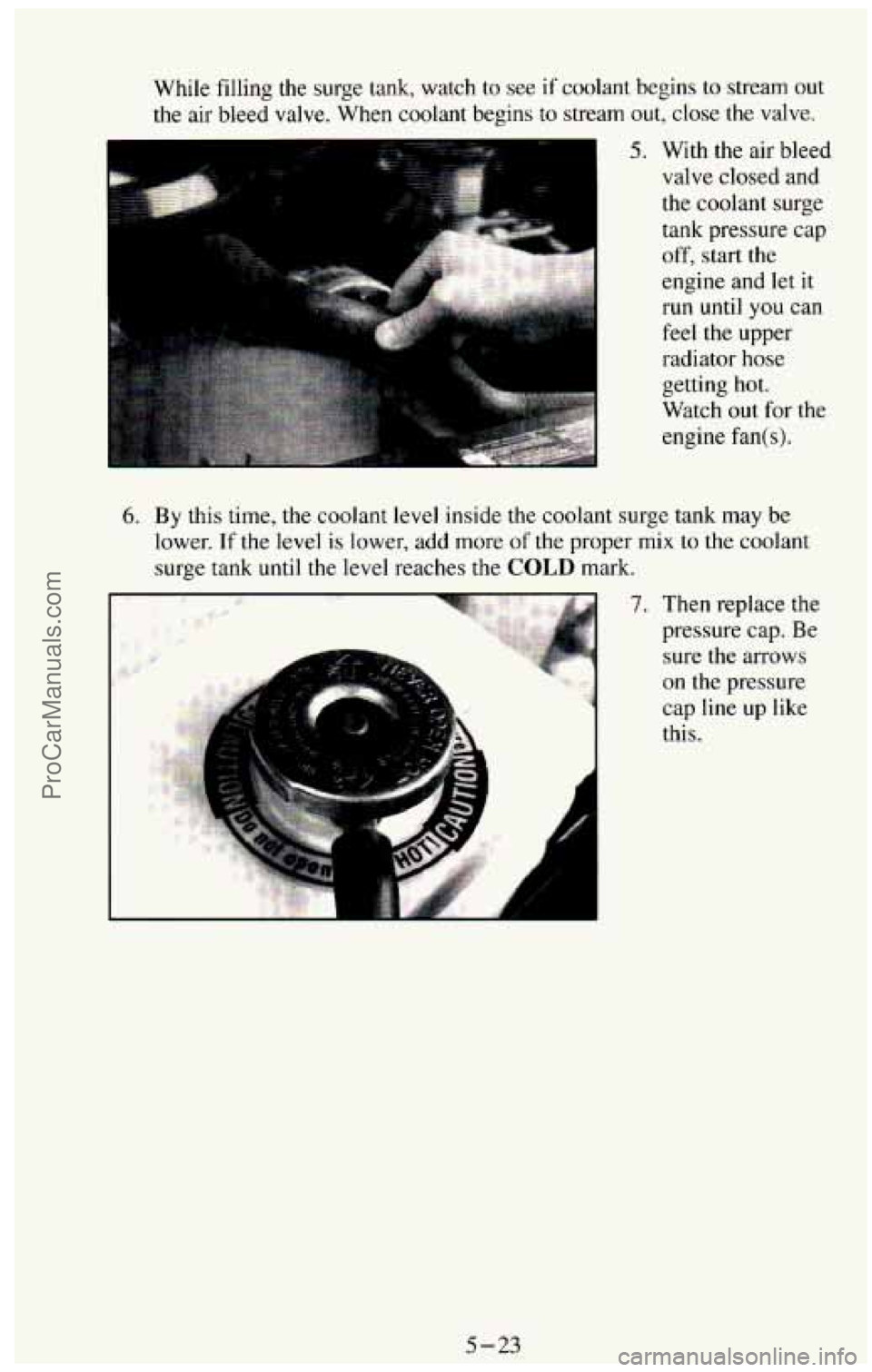
While filling the surge tank, watch to see if coolant begins to stream out
the air bleed valve. When coolant begins to stream out, close the valve.
5. With the air bleed
valve closed and
the coolant surge
tank pressure cap
off, start the
engine and let
it
run until you can
feel
the upper
radiator hose
getting hot.
Watch out for the
engine fan(
s).
6. By this time, the coolant level inside the coolant surge tank may be
lower.
If the level is lower, add more of the proper mix to the coolant
surge tank until the level reaches the
COLD mark.
7. Then replace the
pressure cap.
Be
sure the arrows
on the pressure
cap line up like
this.
5-23
ProCarManuals.com
Page 246 of 385
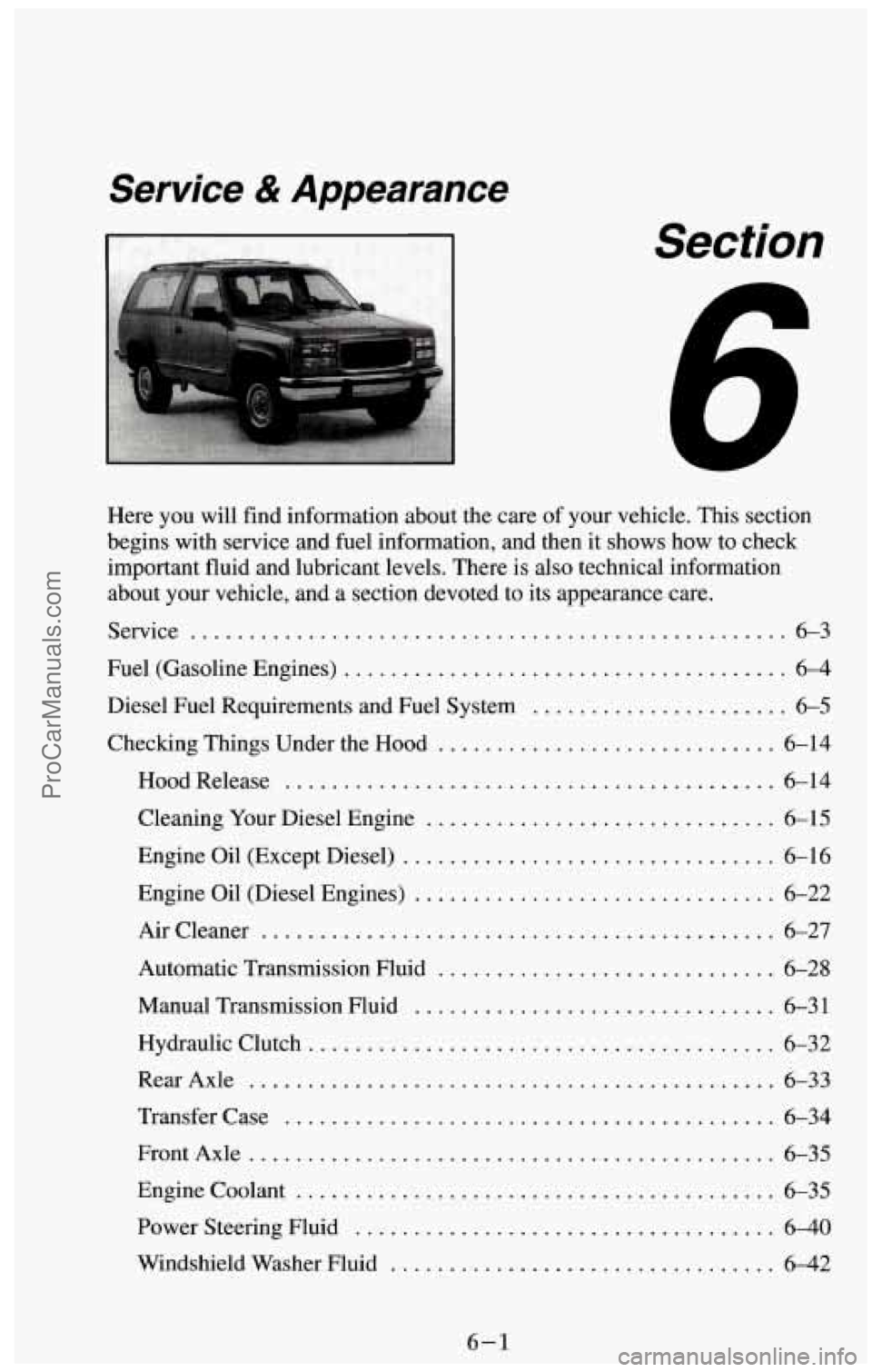
Service & Appearance
I Section
Here you will find information about the care of your vehicle . This section
begins with service and fuel information. and then it shows how to check
important fluid and lubricant levels
. There is also technical information
about your vehicle. and a section devoted to its appearance care
.
Service ................................................... 6-3
Fuel (Gasoline Engines)
............................
Diesel Fuel Requirements and Fuel System ..........
Checking Things Under the Hood ........... .....
........ 6-4
.......... 6-5
......... 6-14
HoodRelease
.......................................... 6-14
Cleaning Your Diesel Engine
............................ 6-15
Engine Oil (Except Diesel)
................................ 6-16
Engine Oil (Diesel Engines)
............................... 6-22
Aircleaner
.................... .................. 6-27 ..
Automatic Transmission Fluid ............................. 6-28
Manual Transmission Fluid
............................... 6-31
Hydraulic Clutch
........................................ 6-32
RearAxle
............................................. 6-33
Transfer Case
.......................................... 6-34
FrontAxle
........................................... 6-35
Engine Coolant
......................................... 6-35
Power Steering Fluid
.............. .................. 640
Windshield Washer Fluid
............................... 6-42
6-1
ProCarManuals.com
Page 280 of 385
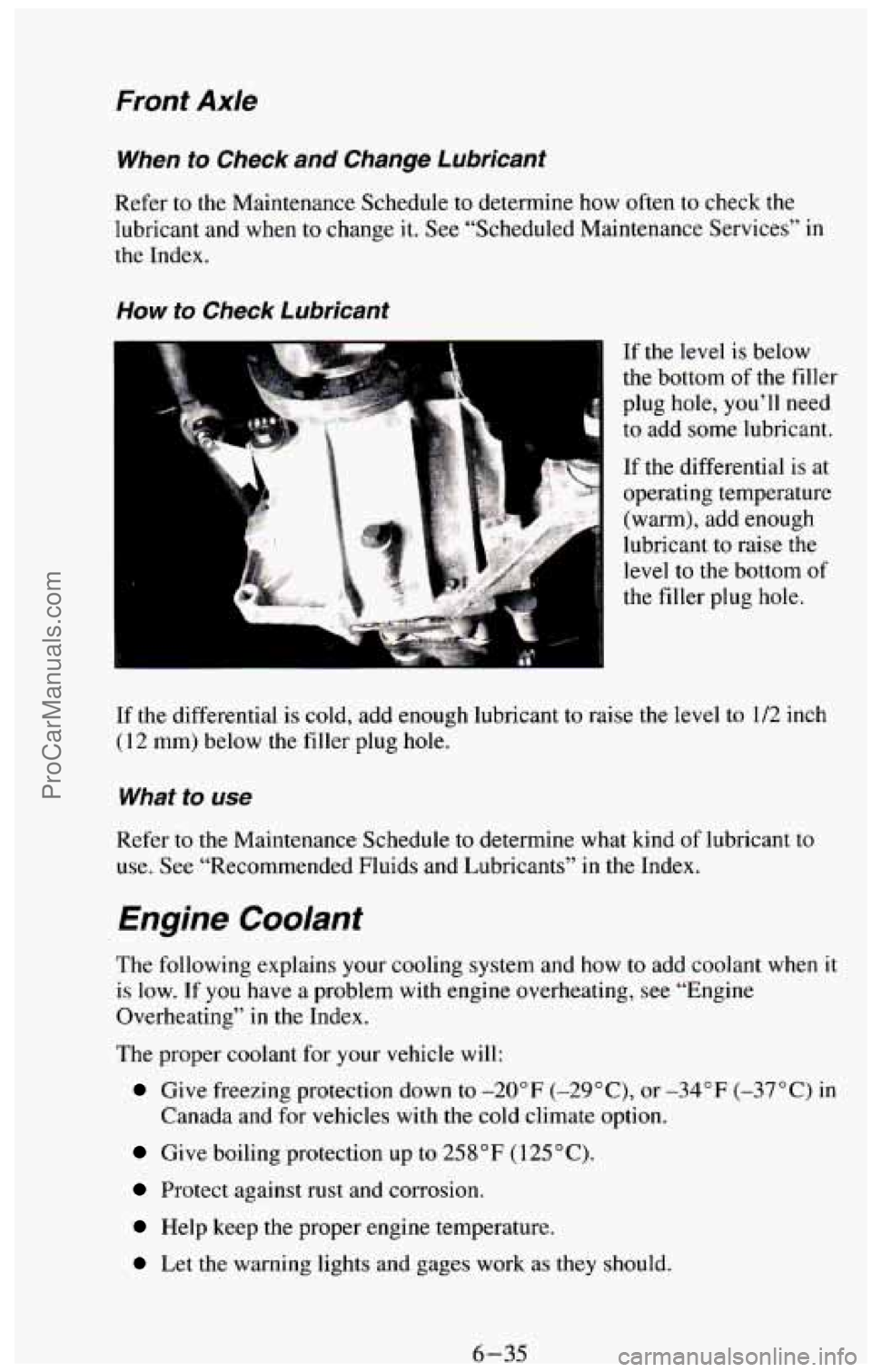
Front Axle
When to Check and Change Lubricant
Refer to the Maintenance Schedule to determine how often to check the
lubricant and when to change
it. See “Scheduled Maintenance Services” in
the Index.
How to Check Lubricant
If the level is below
the bottom of the filler
plug hole, you’ll need
to add some lubricant.
If the differential is at
operating temperature
(warm), add enough
lubricant to raise the level
to the bottom of
the filler plug hole.
If the differential is cold, add enough lubricant to raise the level to
1/2 inch
(12 mm) below the filler plug hole.
What to use
Refer to the Maintenance Schedule to determine what kind of lubricant to
use. See “Recommended Fluids and Lubricants” in the Index.
Engine Coolant
The following explains your cooling system and how to add coolant when it
is low. If you have a problem with engine overheating, see “Engine
Overheating”
in the Index.
The proper coolant for your vehicle will:
Give freezing protection down to -20°F (-29”C), or -34°F (-37°C) in
Give boiling protection up to 258°F (1 25°C).
Protect against rust and corrosion.
Help keep the proper engine temperature.
Canada
and for vehicles with the cold climate option.
Let the warning lights and gages work as they should.
6-35 ProCarManuals.com
Page 281 of 385
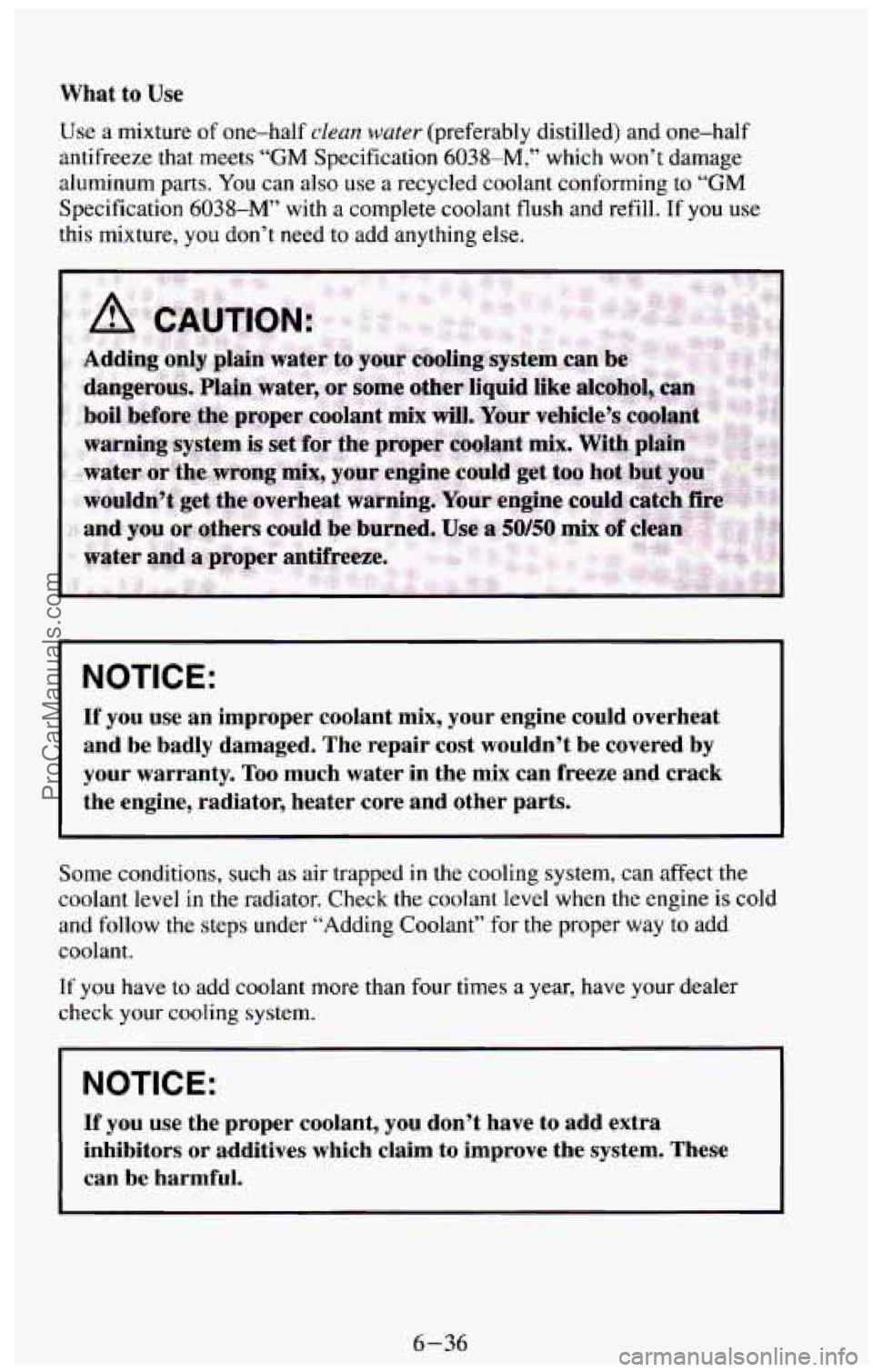
What to Use
use a mixture of one-half clean water (preferably distilled) and one-half
antifreeze that meets
“GM Specification 6038-M,” which won’t damage
aluminum
parts. You can also use a recycled coolant conforming to “GM
Specification 6038-M” with a complete coolant flush and refill. If you use
this mixture, you don’t need
to add anything else.
NOTICE:
If you use an improper coolant mix, your engine could overheat
and be badly damaged. The repair cost wouldn’t be covered by
your warranty.
TOO much water in the mix can freeze and crack
the engine, radiator, heater core and other parts.
Some conditions, such as air trapped in the cooling system, can affect the
coolant level in the radiator. Check the coolant level when the engine is cold
and follow the steps under “Adding Coolant” for
the proper way to add
coolant.
If you have to add coolant more than four times a year, have your dealer
check your cooling system.
NOTICE:
If you use the proper coolant, you don’t have to add extra
inhibitors
or additives which claim to improve the system. These
can be harmful.
6-36
ProCarManuals.com